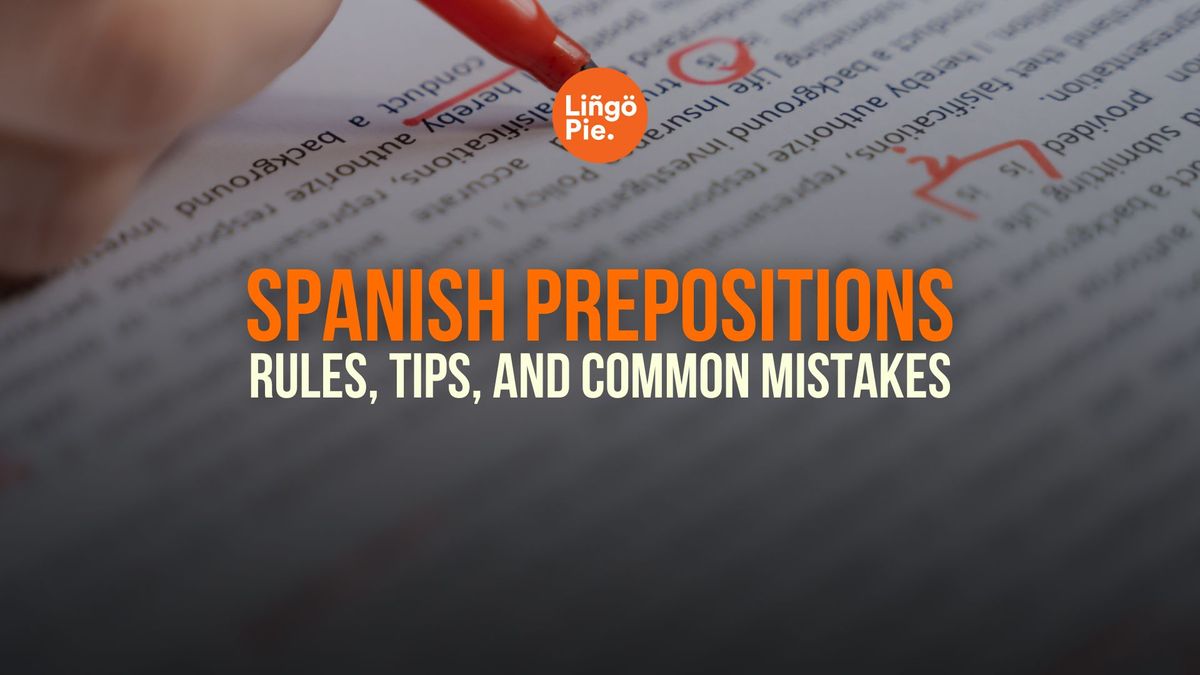Want to speak Spanish like a native? Then you'll need to get cozy with prepositions – those small but mighty words that can make or break your Spanish sentences. Think of prepositions like por, para, con, contra, de, and a as the glue that holds your Spanish together.
Sure, you might know how to say "I go store" (Yo voy tienda), but without the right preposition, you're missing the critical "to" that makes it "I go to the store" (Yo voy a la tienda). While these little words might seem tricky at first (especially since some, like por and para, both mean "for" in English), mastering them will take your Spanish from robotic to natural.
In this post, I'll introduce you to some of the most commonly used Spanish prepositions in Spanish grammar. I'll also give you tips and example sentences to truly help you identify and understand each.
- How To Say Cheers In Spanish: 5+ Easy Toasts
- Spanish Curse Words: 20+ Crazy Bad Words In Spanish
- 21+ Charming Spanish Compliments to Brighten People's Day

What Are Spanish Prepositions?
Las preposiciones or Spanish prepositions are essential connecting words that link different parts of a sentence to show relationships between things, places, people, and actions. Think of them as traffic signs in a sentence – they direct your listener to understand exactly what you mean. Spanish prepositions fall into four main categories:
- Space = "El gato está debajo de la mesa" = "The cat is under the table"
- Time = "Llegaré a las tres" = "I'll arrive at three"
- Manner = "Lo hice con cuidado" = "I did it with care"
- Possession = "El libro de Juan" = "Juan's book"
Understanding these categories makes it much easier to use prepositions correctly in your everyday Spanish conversations.
Common Spanish Prepositions For Beginners
Simple Prepositions In Spanish
These are the one-word powerhouses of Spanish: a (to), de (of/from), en (in/on), con (with), por (for/by), and para (for). You'll drop these into nearly every Spanish conversation you have so they're impossible to avoid when learning Spanish.
| Spanish | English | Spanish Example | English Translation |
|---|---|---|---|
| a | to | Voy a casa | I'm going home |
| ante | before/in front of | Ante la puerta | Before the door |
| bajo | under | Bajo el árbol | Under the tree |
| con | with | Como con María | I'm eating with Maria |
| de | of/from | Soy de México | I'm from Mexico |
| desde | from/since | Desde las tres | Since three o'clock |
| en | in/on | Estoy en casa | I'm at home |
| entre | between | Entre semana | During the week |
| hacia | toward | Voy hacia allá | I'm heading that way |
| hasta | until | Hasta mañana | See you tomorrow |
| para | for | Es para ti | It's for you |
| por | for/by | Por la mañana | In the morning |
| sin | without | Café sin azúcar | Coffee without sugar |
| sobre | on/above | Sobre la mesa | On the table |
Compound Prepositions In Spanish
When you need to be more specific about the location or relationship between things, compound prepositions come into play. Made up of multiple Spanish words like delante de (in front of), detrás de (behind), junto a (next to), and cerca de (near), these phrases help paint a clearer picture.
| Spanish | English | Spanish Example | English Translation |
|---|---|---|---|
| delante de | in front of | Delante de la casa | In front of the house |
| detrás de | behind | Detrás del árbol | Behind the tree |
| dentro de | inside | Dentro del carro | Inside the car |
| encima de | on top of | Encima del libro | On top of the book |
| debajo de | under | Debajo de la cama | Under the bed |
| cerca de | near | Cerca de la playa | Near the beach |
| lejos de | far from | Lejos de la ciudad | Far from the city |
| junto a | next to | Junto al banco | Next to the bank |
| frente a | across from | Frente al parque | Across from the park |
| alrededor de | around | Alrededor del parque | Around the park |
Spanish Prepositions For Advanced Learners

Origin And Destination
At an advanced level, Spanish prepositions can express nuanced movement patterns, including purpose and method.
| Spanish | English |
|---|---|
| rumbo a | heading to |
| con dirección a | in the direction of |
| en busca de | in search of |
| camino a | on the way to |
| procedente de | coming from |
| con destino a | destined for |
| de ida y vuelta | round trip |
| en dirección a | toward |
| en ruta a | en route to |
| vía | via/by way of |
Examples:
- "Paso por Madrid rumbo a Barcelona" (I'm passing through Madrid on my way to Barcelona)
- "Vine desde lejos en busca de trabajo" (I came from far away in search of work)
- "El tren procedente de Madrid está en ruta a París" (The train coming from Madrid is en route to Paris)
Geographical Location
When expressing location on a map or in relation to geographical features, Spanish uses specific preposition combinations to convey precise meanings.
| Spanish | English |
|---|---|
| al norte/sur de | north/south of |
| al este/oeste de | east/west of |
| en el interior de | inland/in the interior of |
| en las afueras de | in the outskirts of |
| en el centro de | in the center of |
| a orillas de | on the shores of |
| a lo largo de | along |
| en medio de | in the middle of |
| en los alrededores de | in the surroundings of |
| a las afueras de | on the outskirts of |
Examples:
- "Vivimos en las afueras de Madrid" (We live in the outskirts of Madrid)
- "El hotel está a orillas del mar" (The hotel is on the seashore)
- "El pueblo está en el interior del país" (The town is in the country's interior)

Physical Locations
Spanish uses specific preposition combinations to describe the precise location of objects in relation to each other or within a space.
| Spanish | English |
|---|---|
| a la altura de | at the level of |
| al borde de | at the edge of |
| en el fondo de | at the bottom of |
| en la cima de | at the top of |
| en la superficie de | on the surface of |
| a la entrada de | at the entrance of |
| a la salida de | at the exit of |
| a la derecha/izquierda de | to the right/left of |
| en la esquina de | in the corner of |
| a mitad de | halfway through |
Examples:
- "El restaurante está a la altura del primer piso" (The restaurant is at the first floor level)
- "Hay una tienda a la entrada del centro comercial" (There's a store at the entrance of the mall)
- "El libro está en el fondo del estante" (The book is at the bottom of the shelf)
Movement
Spanish uses specific preposition combinations to describe how something or someone moves through space, including direction, manner, and path.
| Spanish | English |
|---|---|
| alrededor de | around |
| a través de | through |
| a lo largo de | along |
| hacia adelante | forward |
| hacia atrás | backward |
| por encima de | over/above |
| por debajo de | underneath |
| a través de | across/through |
| de un lado a otro | from side to side |
| en dirección a | in the direction of |
Examples:
- "El pájaro voló por encima de la casa" (The bird flew over the house)
- "Caminamos a lo largo del río" (We walked along the river)
- "El gato se movió de un lado a otro" (The cat moved from side to side)

Relationships
Spanish uses specific preposition combinations to describe connections, associations, and relationships between people, things, or ideas.
| Spanish | English |
|---|---|
| en cuanto a | regarding/with respect to |
| en relación con | in relation to |
| acerca de | about/concerning |
| respecto a | with respect to |
| a favor de | in favor of |
| en contra de | against |
| junto con | together with |
| además de | in addition to |
| aparte de | apart from |
| en comparación con | in comparison with |
Examples:
- "En relación con tu pregunta..." (Regarding your question...)
- "Estamos a favor de la propuesta" (We are in favor of the proposal)
- "Todos votaron en contra de la idea" (Everyone voted against the idea)
Time
Spanish uses specific preposition combinations to express more complex time relationships, including duration, specific moments, and sequences.
| Spanish | English |
|---|---|
| a partir de | starting from |
| a lo largo de | throughout |
| dentro de | within |
| alrededor de | around (time) |
| en vísperas de | on the eve of |
| a eso de | around/about (time) |
| antes de | before |
| después de | after |
| desde hace | since/for |
| hasta dentro de | until/in |
Examples:
- "A partir de mañana empiezo el trabajo" (Starting from tomorrow, I begin work)
- "La reunión es a eso de las tres" (The meeting is around three)
- "He vivido aquí desde hace cinco años" (I have lived here for five years)
Spanish Preposition Rules
Ever wondered where exactly to put those Spanish prepositions and how they sometimes morph together? Let's break down these important rules that'll help you sound more natural in Spanish.
Rule #1: Spanish Preposition Placement
Spanish prepositions always come before the word they modify. It's that simple. In English, you might say "Who are you going with?" but in Spanish, you say "Con quién vas?" (With whom are you going?). This rule never changes – the preposition always goes first, making your sentences clear and correct.
- de + el libro = del libro (of the book)
- de + el parque = del parque (from the park)
- de + el doctor = del doctor (of the doctor)
- de + el aeropuerto = del aeropuerto (from the airport)
- de + el restaurante = del restaurante (of the restaurant)
Rule #2: Spanish Preposition Contractions
While English has contractions like "don't" or "isn't," Spanish has its own unique set that work differently. These contractions aren't optional – they're mandatory in Spanish speech and writing.
| Combination | Contraction | Spanish Example | English Translation |
|---|---|---|---|
| a + el | al | Voy al banco | I'm going to the bank |
| de + el | del | Vengo del trabajo | I'm coming from work |
| con + mí | conmigo | Ven conmigo | Come with me |
| con + ti | contigo | Voy contigo | I'm going with you |
| con + sí | consigo | Lo llevó consigo | He took it with him |
One thing to remember though is that al and del only work with masculine singular article el. Additionally, note that the personal pronouns (conmigo, contigo, consigo) are always written as one word and never separate.
Common Mistakes with Spanish Prepositions
One of the trickiest parts of learning Spanish grammar is that prepositions don't translate directly from English. For instance, when we think about something in English, many learners mistakenly say "pienso de" in Spanish, copying the English structure. However, the correct form is "pienso en." The same goes for dreaming – while English uses "dream about," Spanish pairs "soñar" with "con" (soñar con).
❌ Pienso de mi futuro
✅ Pienso en mi futuro
❌ Sueño de viajar
✅ Sueño con viajar
Time expressions often trip up English speakers too. We naturally want to say "en la mañana" (in the morning) or "en lunes" (on Monday), but Spanish uses different prepositions – or sometimes none at all. Parts of the day use "por" (por la mañana, por la tarde, por la noche), while days of the week just need "el" (el lunes, el martes).
❌ Trabajo en la mañana y estudio en la noche
✅ Trabajo por la mañana y estudio por la noche
❌ Descanso en el fin de semana
✅ Descanso el fin de semana
Another common error involves Spanish verbs like "mirar" (to look at) and "esperar" (to wait for). While English needs "at" after "look" and "for" after "wait," Spanish treats these differently. "Mirar" doesn't need a preposition for objects, and "esperar" uses "a" for people, not "por" as you might expect from the English "wait for."
❌ Miro a la televisión
✅ Miro la televisión
❌ Espero por mi amigo
✅ Espero a mi amigo
For more Spanish grammar tips, check our grammar guide!
Learn Spanish Preposition With Lingopie
While memorizing rules is helpful, the best way to internalize these preposition patterns is through consistent exposure to natural Spanish. Remember, even if you make mistakes, native speakers will understand you – the key is to keep practicing and learning from each conversation.
Want to hear how native speakers use these prepositions in real-life situations? Check out Lingopie's extensive library of Spanish TV shows and movies. With authentic content from across the Spanish-speaking world, you'll learn how prepositions are used in everyday conversations, slang, and different regional dialects.
Plus, Lingopie's interactive features let you pause, replay, and review scenes, making it easier to catch and practice these preposition patterns in context. Ready to take your Spanish to the next level? Start watching on Lingopie today and turn your screen time into learning time!









